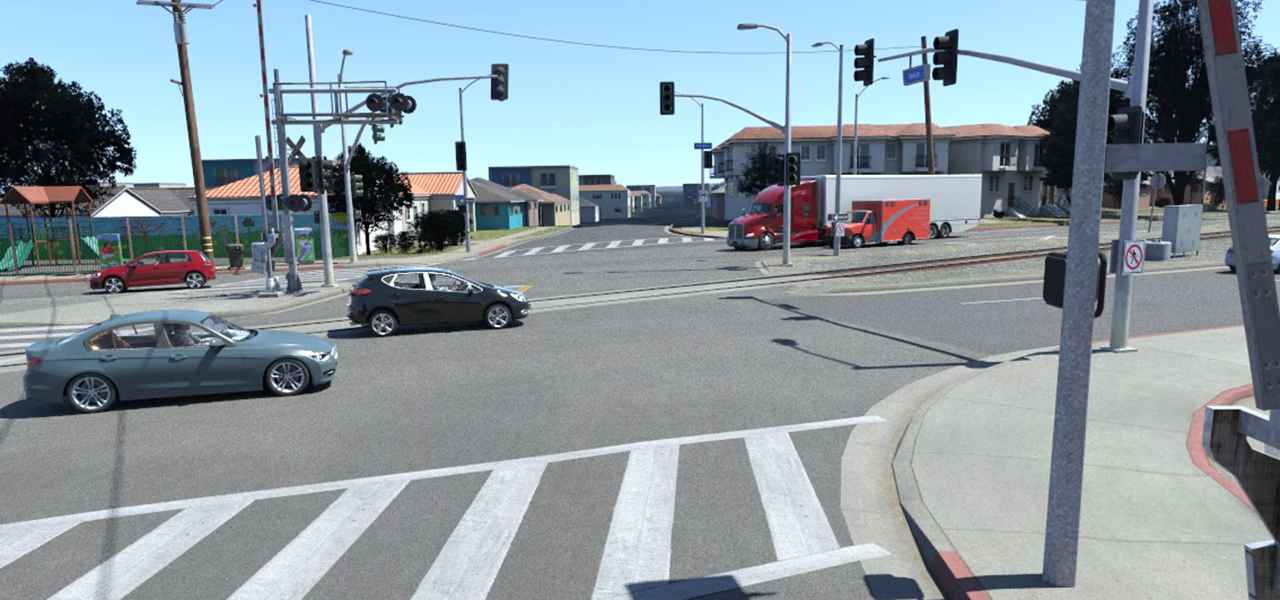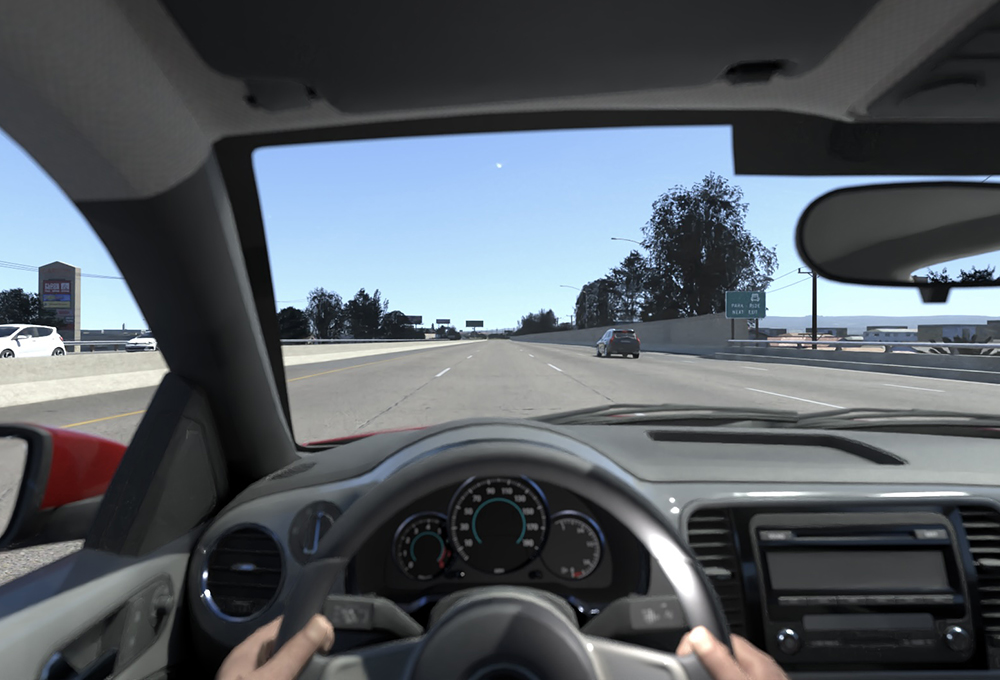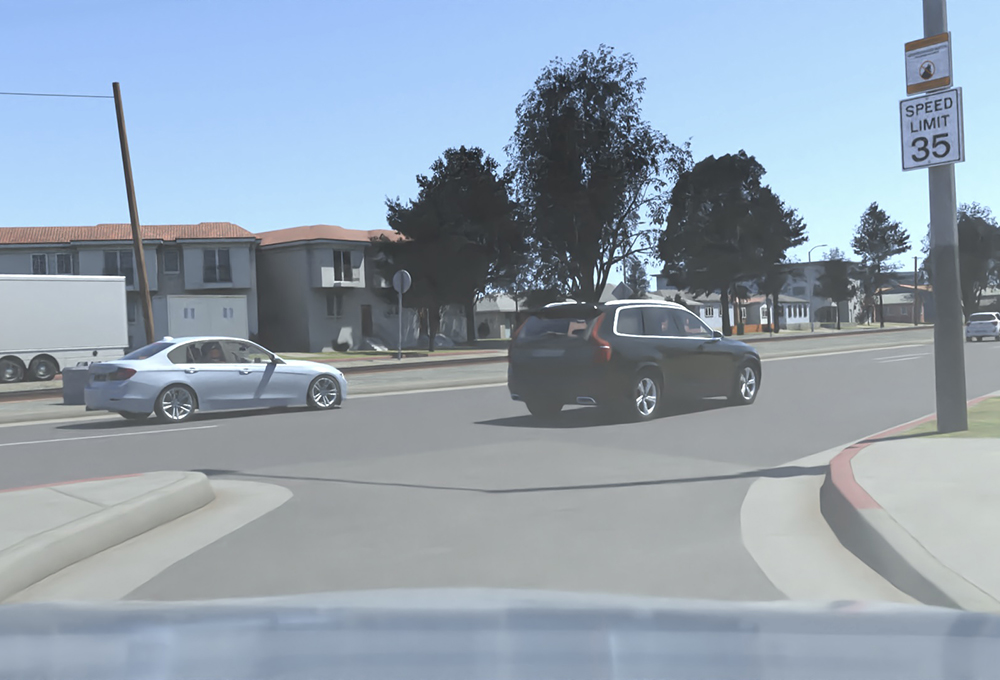 这是rFpro新发布的洛杉矶数字地图的一个场景,该地图覆盖了一条全长36公里(22英里)的双向行驶环形路。(rFpro)
这是rFpro新发布的洛杉矶数字地图的一个场景,该地图覆盖了一条全长36公里(22英里)的双向行驶环形路。(rFpro) rFpro技术总监Matt Daley在 2024年美国AutoSens展会。(SEBASTIAN BLANCO)
rFpro技术总监Matt Daley在 2024年美国AutoSens展会。(SEBASTIAN BLANCO) rFpro的新洛杉矶地图包括12,000多座建筑、13,000个基础设施(标志和灯具)以及40,000种植物。(rFpro)
rFpro的新洛杉矶地图包括12,000多座建筑、13,000个基础设施(标志和灯具)以及40,000种植物。(rFpro) 洛杉矶地图数据集包括各种现实世界变量,如铁路道口、加油站、十字路口和高速公路上下匝道。(rFpro)
洛杉矶地图数据集包括各种现实世界变量,如铁路道口、加油站、十字路口和高速公路上下匝道。(rFpro)
现在,您可以从任何地方驾车环游洛杉矶的各个社区,全程 36 公里(22 英里)。
截至目前,仿真公司rFpro已经绘制了全球180多个地点的数字地图,其中包括公共道路、测试场地和赛车赛道。然而,这些地图的规模及复杂程度都比不上该公司最新推出的一款数字地图。rFpro技术总监Matt Daley在AutoSens USA 2024上称,这款新推出的洛杉矶数字地图是一个“无比巨大且复杂的数字模型”,覆盖了一条全长36公里(22英里)的双向行驶环形路,用户可在其中虚拟驾驶。其中的数字道路是使用勘测级激光雷达数据在1cm×1cm(1.1″×1.1″)的X-Y网格上构建的,地图中还包含超过12000栋路边建筑物、13000个街道基础设施(如交通标志和路灯)和40000株植被。
Daley告诉SAE:“自动驾驶汽车在研发时面临的一大挑战是必须获取大量多元化数据,然而在真实道路测试中很难做到这点,因为这需要行驶大量的里程、覆盖许多不同地点,并累积足够的数据才能做到。而仿真测试则不同,我们可以直接创建多元化场景,也可以让客户在现有数字地图上添加次级的多元数据。”
Daley指出,“我们意识到,凭借我们为构建可靠的仿真平台和基础设施投入的资金,以及我们创建3D模型的技术和能力,我们便可以添加新的数据层。我们知道这样做就等于改变了产品的性质,而且必须赋予新模型新的功能,因为它的应用领域将不限于有人驾驶场景。我们必须在该模型上添加数字摄像头,但摄像头不同于人眼,它们通常在不同的时间段对周围环境进行采样。而且,我们还需要使用雷达模型和激光雷达模型,因此我们创建了传感器API系统,以便对插件进行建模,并将其作为额外通道集成至仿真模型中。”
rFpro控股公司AB Dynamics PLC于2022年收购了Ansible Motion,后者不仅提供3D全动态平台硬件,还提供完整的集成解决方案。Daley表示,“除了Ansible外,我们有一些合作伙伴或经销商也将“rFpro地图”集成至其自身硬件上。同时,我们的很多客户也会自己集成。比如,早在2014年我还是法拉利的客户时,我们对法拉利自主研发的模拟器进行了改装,并将rfPro地图整合进了模拟器,通过升级现有系统,使其具有更高的保真度。为什么这一点很重要?因为客户可以利用我们的仿真模型创建成几十万个不同边缘场景的不同测试,也可以利用这个基于真实地点构建的复杂高精度模型,重新创建一些在现实世界中可能发生的已知风险事件。”
Daley表示,“只有在相信模拟结果的前提下,你才能实现这一目标。如果仿真模型是采用虚构地点创建的,那么就很难将仿真结果与现实情况联系起来。基于真实地点创建的仿真模型具有很大的价值,能够让我们有信心扩展仿真应用的规模。”
Simulation company rFpro has already mapped over 180 digital locations around the world, including public roads, proving grounds and race circuits. But the company’s latest is by far its biggest and most complicated. Matt Daley, technical director at rFpro, announced at AutoSens USA 2024 that its new Los Angeles route is an “absolutely massive, complicated model” of a 36-km (22-mile) loop that can be virtually driven in both directions. Along these digital roads – which were built off survey-grade LIDAR data with a 1 cm by 1 cm (1.1-in by 1.1 in ) X-Y grid – rFpro has added over 12,000 buildings, 13,000 pieces of street infrastructure (like signs and lamps), and 40,000 pieces of vegetation.
“It’s a fantastic location,” Daley said. “It’s a huge array of different types of challenging infrastructure for AVs. You can drive this loop with full vehicle dynamic inputs, ready to excite the suspension and, especially with AVs, shake the sensors in the correct way as you would be getting if you were driving those real roads.”
The new digital map covers an area in southwest LA that includes Highway 110 from the harbor up to Carson, going through industrial areas, dense residential areas in Torrance, and suburban Rolling Hills. The variety is what makes this new model so valuable to companies that want to simulate various tests, especially for new automated driving systems.
“We are now able to give autonomous vehicles the ability to test in all of these different types of environments, junctions, and road types that they’re going to experience in day-to-day life,” Daley said, adding that there are railroad crossings, gas stations, intersections, and highway on- and off-ramps in the data set.
“The grand challenge of autonomous development is that you need so much diversity available to you,” Daley told SAE Media. “It’s extremely difficult to get in the real world, because you have to go so many different miles, so many places, and really drive so much volume in order to create it. It’s a slightly different challenge in simulation, because we can create diversity and let people create second levels of diversity inside existing maps.”
Not just for human drivers
RFpro started in 2007 in the driver-in-the-loop market. In 2015, the company started to think about how to integrate ADAS testing.
“We realized that the amount of investment that we got in providing a solid simulation platform and infrastructure, as well as our technologies and abilities to build 3D models, we could add additional layers,” Daley said. “We knew it wouldn’t be the same product, we had to keep adding additional functionality because it was no longer just humans that were looking into this. We had to add digital eyes, and cameras are not human eyes. They are different in the way that they sample the world over different time periods. And then [we needed] lidar and radar models as well, so we created the sensor API system to allow plugins to be modeled, and to come and sit in as additional channels in the simulation.”
No matter if a human or a digital driver is viewing the scene in an rFpro map, it uses the same geometric world, Daley said, including what all the materials are made of. Humans will see the virtual world displayed with an eight-bit RGB color per pixel, but a simulated camera might process a “higher-bit image that gets passed on through a perception system down the chain,” Daley said. “The fundamentals of the world and how you calculate the physics in the world are still the same. It all comes down to how do you present that onwards in the correct format for how the sensor needs to see.”
AB Dynamics PLC, which also owns rFpro, acquired Ansible Motion in 2022. Ansible provides 3D full-motion platform hardware and can do full integrated solutions, Daley said. “We have other partners and other resellers that integrate [our maps] onto their own hardware,” he said. “A lot of our customers do it themselves as well. I was a customer at Ferrari back in 2014, when we converted an in-house simulator they had and brought rfPro onboard and upgraded an existing system with a higher fidelity world. And why does this matter? Well, it’s the virtual playground that allows our customers to create hundreds of 1,000s of different tests of different edge cases and to recreate some of the known hazardous events that can happen in the real world in a highly accurate model of a real-world location, with the real world complexities that are there.”
Daley said rFpro’s system also allows customers to “generate things that didn’t happen, that you couldn’t find by doing real-world drives, because you simply do not have enough time, money, resources, vehicles, or the pure luck of finding the combination of weather and vehicles and pedestrians all doing the edge case scenarios that you need. Because [the LA map is] a real-world location, you can also correlate, you can do matching tests in your simulation and your real-world location to build your level of confidence in the simulation that really helps you to exploit the power of using synthetic training data.”
Rfpro’s new LA route can be driven in real-time with a human-in-the-loop driver or used in a simulator with full-fidelity ray tracing to generate complicated high-fidelity sensables, providing tens of thousands of tests in a short time. Digital cameras can also simulate edge cases, with nuances that come from having motion blur in an image or with full rolling-shutter effects that each OEM can define for each of their sensors. “It produces the highest fidelity training data to go into autonomous systems, and it’s built on top of and alongside industry led sensable integrations,” Daley said.
Overall, the LA map is rFpro’s best example of a map based on the real world that can provide automated driving tech companies with confidence that what they find in the simulator will match what might happen in the real world.
“You can only get to that position if you have confidence in your simulation,” Daley said. “It's pretty impossible to correlate your simulation if that thing is not a real location, if you're just making up a location. Having real world locations is hugely valuable to actually give you that confidence to scale.”
等级
打分
- 2分
- 4分
- 6分
- 8分
- 10分
平均分
- 作者:SEBASTIAN BLANCO
- 行业:汽车
- 主题:管理与产品开发材料质量、可靠性与耐久性运输系统
